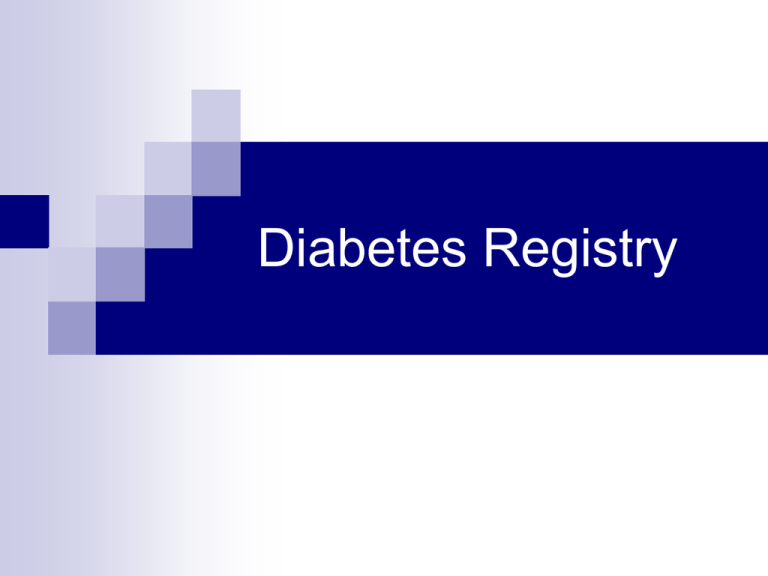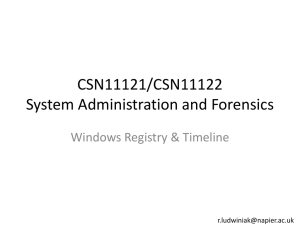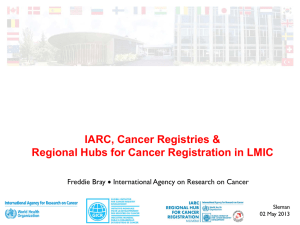Diabetes Registry
advertisement

Diabetes Registry The Care Model Community Health System Health Care Organization Resources and Policies SelfManagement Support Delivery System Design Informed, Productive Empowered Interactions Patient Decision Support Clinical Information Systems Prepared, Proactive Practice Team Improved Outcomes You are here Clinical Information Systems Organize patient and population data to facilitate efficient and effective care. Provide timely reminders for providers and patients. Identify relevant subpopulations for proactive care. Facilitate individual patient care planning. Share information with patients and providers to coordinate care. Monitor performance of practice team and care system. Diabetes Registry Web-based disease-management tool accessible anywhere within HHC Supports HHC's Chronic Disease Collaborative Simplifies point-of-care and quality improvement Displays clinical measures and quality indicators Provides “at-a-glance” view of care team performance and immediate access to individual patients requiring additional interventions. Registry Components Patient Specific Profile Highlights need for routine interventions Provide feedback to caregiver and patient about progress and goals Integrate dynamically with decision support* Population Care Planning Identify all patients in need of routine services Provide lists of patients not reaching goals Be able to stratify/view sub-populations Registry Components Care Team Specific Feedback How is the population doing? Are we improving? Are there best practices out there? Diabetes Measures Outcomes HbA1c levels Self management documentation Fasting LDL Blood pressure Processes Annual foot exam Annual retinal eye exam Annual screening for nephropathy Screening for depression (PHQ2 – PHQ9) Fears and Facts about Registries Fear: Why do we have to have a registry? Fact: Planned population-based care cannot be done without knowing your patient population and its key clinical data Fact: Primary care teams that implement registries are more likely to improve processes of care for all chronic conditions Fact: Teams with registries are less likely to lose patients to follow-up, and more likely to improve patient satisfaction as care improves Fear: I don’t need anyone telling me how to practice! I’m doing just fine with my patients! Fact: Surveys show that providers consistently under estimate the numbers of patients with chronic disease in their practice Fact: Surveys show that provider consistently over estimate their performance measures on process and clinical outcomes for chronically ill patients. Fact: The two are interdependent. Fact: Knowing you population of patients will help rectify this disparity. Fear: It’s just more work during our already hectic day! Fact: Using a patient summary form from a Registry will actually reduce charting time and make the visit run more smoothly Fact: The form gives a snapshot of past care, reminders of needed care and planning for future care all at the time of the visit Fact: Teams with registries feel better prepared for visits since they have the patient information when and where they need it. How to use the Registry How to Access the Diabetes Registry 1. At NBHN – HOME, double click “Intranet” 2. On the side bar double click “Patient Registry” 3. Enter Username and Password. (If you do not know your username contact Maria Mendoza @ 36009) Click on “Login” 4. You will see this screen. If it is not your registry, click the “v” to open the window 5. Click on your name to open your registry. 6. Once you are in your registry, to find a list of all your patients double click on “Patients” 7. This screen will appear. 8. To see individual patient record click on the box on the first column and double click on the patient’s name. 9. You will see this screen. There’s a wealth of information you will find. If you want to create a letter double click on “Create Letter”. If you call this patient double click on “Log Call” and document your call. “Contact Hx” – shows you all the outreach letters and calls the patient received. Click on Indicators, Measures, Visits, Problems, etc to find out more information about your patient. For other features of the Registry, check on “How to Use the Diabetes Registry” in the Intranet How Should We Use the Registry? We would like you to open up your registry at the start of every session in outpatient practice. See if the patient who you are seeing with DM is on your registry? Does this patient have another primary provider? If not, this patient should be on your registry and you should see this patient in continuity. Let the supervising attending know that you need to add this patient to your registry The goal is for each patient to have a regular provider for continuity of care. Using the registry will help you manage your patients and also help us assure continuity of care Using the registry…. We expect you to review your registry regularly and often If you see patients on your registry whom you have not seen – please let Maria Mendoza, Dr Weinstein or any of the supervising attendings know – we will remove them from your registry and place them with the correct provider. We will be monitoring your use of the registry---YES, big brother is watching! We want to see that you are using the registry and also that your patients are improving and getting the care that they need. Use the registry to see who needs an appointment to see you – who needs more intensive care, who needs an appointment to see the ophthalmologist Be creative and proactive with your patients. If you know you will be on ambulatory and have more time to see patients – look at your registry and ask to have particular patients in need scheduled with you Use the registry to do advanced searches - or even send letters to your patients about their successes!











